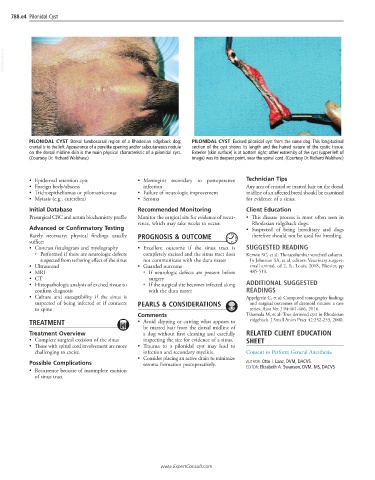Page 1566 - Cote clinical veterinary advisor dogs and cats 4th
P. 1566
788.e4 Pilonidal Cyst
VetBooks.ir
PILONIDAL CYST Dorsal lumbosacral region of a Rhodesian ridgeback dog; PILONIDAL CYST Excised pilonidal cyst from the same dog. This longitudinal
cranial is to the left. Appearance of a porelike opening and/or subcutaneous nodule section of the cyst shows its length and the haired nature of the cystic tissue.
on the dorsal midline skin is the main physical characteristic of a pilonidal cyst. Exterior (skin surface) is at bottom right; other extremity of the cyst (upper left of
(Courtesy Dr. Richard Walshaw.) image) was its deepest point, near the spinal cord. (Courtesy Dr. Richard Walshaw.)
• Epidermal retention cyst • Meningitis secondary to postoperative Technician Tips
• Foreign body/abscess infection Any area of crusted or matted hair on the dorsal
• Trichoepitheliomas or pilomatricomas • Failure of neurologic improvement midline of an affected breed should be examined
• Myiasis (e.g., cuterebra) • Seroma for evidence of a sinus.
Initial Database Recommended Monitoring Client Education
Presurgical CBC and serum biochemistry profile Monitor the surgical site for evidence of recur- • This disease process is most often seen in
rence, which may take weeks to occur. Rhodesian ridgeback dogs.
Advanced or Confirmatory Testing • Suspected of being hereditary and dogs
Rarely necessary; physical findings usually PROGNOSIS & OUTCOME therefore should not be used for breeding.
suffice:
• Contrast fistulogram and myelography • Excellent outcome if the sinus tract is SUGGESTED READING
○ Performed if there are neurologic defects completely excised and the sinus tract does Kerwin SC, et al: Thoracolumbar vertebral column.
suspected from tethering effect of the sinus not communicate with the dura mater In Johnston SA, et al, editors: Veterinary surgery:
• Ultrasound • Guarded outcome small animal, ed 2, St. Louis, 2018, Elsevier, pp
• MRI ○ If neurologic defects are present before 485-513.
• CT surgery
• Histopathologic analysis of excised tissue to ○ If the surgical site becomes infected along ADDITIONAL SUGGESTED
confirm diagnosis with the dura mater READINGS
• Culture and susceptibility if the sinus is Appelgrein C, et al: Computed tomography findings
suspected of being infected or if connects PEARLS & CONSIDERATIONS and surgical outcomes of dermoid sinuses: a case
to spine series. Aust Vet J 94:461-466, 2016.
Comments Tshamala M, et al: True dermoid cyst in Rhodesian
TREATMENT • Avoid clipping or cutting what appears to ridgeback. J Small Anim Pract 42:252-253, 2000.
be matted hair from the dorsal midline of
Treatment Overview a dog without first cleaning and carefully RELATED CLIENT EDUCATION
• Complete surgical excision of the sinus inspecting the site for evidence of a sinus. SHEET
• Those with spinal cord involvement are more • Trauma to a pilonidal cyst may lead to
challenging to excise. infection and secondary myelitis. Consent to Perform General Anesthesia
• Consider placing an active drain to minimize
Possible Complications seroma formation postoperatively. AUTHOR: Otto I. Lanz, DVM, DACVS
• Recurrence because of incomplete excision EDITOR: Elizabeth A. Swanson, DVM, MS, DACVS
of sinus tract
www.ExpertConsult.com

